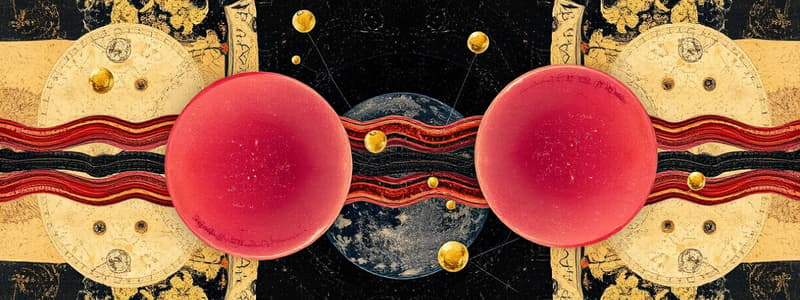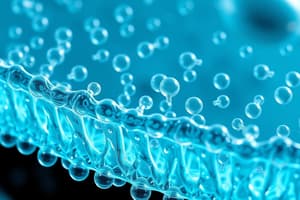Podcast
Questions and Answers
Which of the following is a subtype of phospholipids?
Which of the following is a subtype of phospholipids?
- Cholesterol
- Triglycerides
- Glycolipids
- Plasmalogens (correct)
What is the predominant lipid in cell membranes?
What is the predominant lipid in cell membranes?
Phospholipids
Cholesterol makes up 45% of total membrane lipid content.
Cholesterol makes up 45% of total membrane lipid content.
True (A)
What mode of mobility is NOT permitted for membrane proteins?
What mode of mobility is NOT permitted for membrane proteins?
What is the importance of unsaturated fatty acids in the cell membrane?
What is the importance of unsaturated fatty acids in the cell membrane?
The distribution of different lipids in membranes is ____ specific.
The distribution of different lipids in membranes is ____ specific.
Match the following types of membrane lipids with their descriptions:
Match the following types of membrane lipids with their descriptions:
Membranes contain more carbohydrates than proteins.
Membranes contain more carbohydrates than proteins.
Flashcards are hidden until you start studying
Study Notes
Dynamics in Lipid Bilayers
- Membranes are fluid, allowing for various modes of lipid mobility.
- Modes of mobility include fast lateral diffusion, flip-flop movement, intra-chain motion, and fast axial rotation.
Phospholipids
- Predominant lipids in cell membranes, such as phosphatidylcholine.
- Diverse polar head groups include choline, amines, amino acids, and sugars.
- Fatty acid chains vary in length, with C16 and C18 being most common.
- Unsaturated fatty acids in cis conformation create kinks, reducing packing density.
Plasmalogens
- A subclass of phospholipids found in nervous, immune, and cardiovascular systems.
- Sphingomyelin, a sphingolipid, exists primarily in myelin sheaths surrounding nerve axons.
Glycolipids
- Contain carbohydrate moieties, featuring a hydrophobic fatty acid tail for membrane integration.
- Cerebrosides contain sugar monomers as head groups.
- Gangliosides consist of oligosaccharides, enhancing membrane complexity.
Cholesterol
- Constitutes approximately 45% of total membrane lipid.
- Stabilizes membranes through hydrogen bonding with fatty acid chains.
- Abolishes endothermic phase transitions of phospholipid bilayers while reducing packing.
- Contradictory effects on fluidity: increases overall fluidity but decreases phospholipid chain motion.
Lipid Bilayer
- Formed by amphipathic molecules in water, driven by van der Waals forces.
- Stabilized by non-covalent interactions, including electrostatic and hydrogen bonding.
- Offers low permeability to ions and polar molecules, ideal for cellular barriers.
Functions of Biological Membranes
- Serve as selective permeability barriers, controlling the internal chemical environment.
- Facilitate communication between cells and their environment.
- Enable recognition through signaling molecules, adhesion proteins, and immune functions.
- Generate signals in response to stimuli (electrical, chemical).
Membrane Composition
- Typical composition: ~40% lipid, ~60% protein, and 1-10% carbohydrate.
- Membranes are hydrated, containing about 20% water.
Importance of Membrane Lipids
- Lipids form the double-layered surface essential for cell structure.
- Major classes include phospholipids, glycolipids, and cholesterol.
- Unsaturated fatty acids disrupt packing, enhancing membrane fluidity.
Membrane Proteins
- Integral to functions such as enzyme activity, transport, pumping, ion channels, receptors, and energy transduction.
- Protein content varies between cell types, averaging around 60% of the dry weight in membranes.
Protein Mobility in Bilayers
- Protein movements include conformational changes, rotational, and lateral motions.
- Flip-flop movement is restricted due to the large energy requirement for hydrophilic regions passing through hydrophobic layers.
Restrictions on Protein Mobility
- Lipid-mediated effects lead to separation into fluid phases or cholesterol-poor regions.
- Membrane protein associations restrict mobility.
- Peripheral proteins (e.g., cytoskeleton) further influence membrane protein behavior.
Studying That Suits You
Use AI to generate personalized quizzes and flashcards to suit your learning preferences.



